Enhancing Fire Resistance of Geopolymers Modified with Thermal Insulation Additives
Abstract
:1. Introduction
2. Materials and Methods
- Unmodified Composition (UC): This composition serves as the control, with no modifications introduced through fine additives. It represents the baseline properties for comparison with other modified compositions.
- Minimum Thermal Conductivity (MinTC): This composition was selected for its minimal thermal conductivity coefficient (λ). It aims to provide the best insulation properties among the tested compositions.
- Maximum Thermal Conductivity (MaxTC): In contrast to MinTC, this composition was chosen for its Maximum Thermal Conductivity coefficient (λ). It helps us to understand the effect of increased thermal conductivity on the overall performance of the material.
- Maximum Compressive Strength (MaxCS): This composition was identified for its highest compressive strength (fc). It highlights the potential for enhanced load-bearing capabilities.
- Optimal Technical Properties (OTPs): This composition was selected based on its balanced technical characteristics, including thermal conductivity, compressive strength, and tensile strength. It represents the best overall technical performance.
- Economical Composition (EC): This composition takes into account not only technical performance but also the cost of materials. It represents the optimal balance between technical properties and economic efficiency.
3. Results
4. Discussion
5. Conclusions
- Compressive strength and ultrasonic pulse velocity (UPV): The compressive strength and UPV of geopolymer samples demonstrated a clear dependence on the exposure temperature and duration. At a maximum temperature of 400 °C for 60 min, most compositions showed only minor reductions in compressive strength and UPV, consistent with the range of standard deviations. However, increasing the temperature to 800 °C caused substantial decreases in both metrics, with unmodified samples failing completely. Modified samples exhibited strength reductions between 40% and 70%, highlighting the impact of temperature on material performance.
- Analogies to eco-concrete: The results are analogous to those observed in eco-concrete studies, which also show that compressive strength and structural integrity are maintained up to certain temperatures due to matrix densification. However, beyond these temperatures, significant degradation occurs. Similar to eco-concrete, geopolymer samples exhibited a reduced performance at high temperatures, with changes in UPV indicating structural degradation before significant losses in compressive strength.
- Practical implications: The correlation between UPV and compressive strength suggests that non-destructive testing methods can effectively estimate compressive strength based on structural changes. This can be particularly useful for assessing damage levels in geopolymer components post-fire, without the need for invasive sampling.
Author Contributions
Funding
Institutional Review Board Statement
Informed Consent Statement
Data Availability Statement
Conflicts of Interest
References
- Akbulut, Z.F.; Yavuz, D.; Tawfik, T.A.; Smarzewski, P.; Guler, S. Enhancing Concrete Performance through Sustainable Utilization of Class-C and Class-F Fly Ash: A Comprehensive Review. Sustainability 2024, 16, 4905. [Google Scholar] [CrossRef]
- Kępniak, M.; Łukowski, P. Multicriteria Analysis of Cement Mortar with Recycled Sand. Sustainability 2024, 16, 1773. [Google Scholar] [CrossRef]
- Zerzouri, M.; Bouchenafa, O.; Hamzaoui, R.; Ziyani, L.; Alehyen, S. Physico-chemical and mechanical properties of fly ash based-geopolymer pastes produced from pre-geopolymer powders obtained by mechanosynthesis. Constr. Build. Mater. 2021, 288, 123135. [Google Scholar] [CrossRef]
- Singh, N.B.; Middendorf, B. Geopolymers as an alternative to Portland cement: An overview. Constr. Build. Mater. 2020, 237, 117455. [Google Scholar] [CrossRef]
- Zerzouri, M.; Hamzaoui, R.; Ziyani, L.; Alehyen, S. Comparative Study of the Structural, Microstructural, and Mechanical Properties of Geopolymer Pastes Obtained from Ready-to-Use Metakaolin–Quicklime Powders and Classic Geopolymers. Materials 2024, 17, 4151. [Google Scholar] [CrossRef]
- Prochon, P.; Zhao, Z.; Courard, L.; Piotrowski, T.; Michel, F.; Garbacz, A. Influence of Activators on Mechanical Properties of Modified Fly Ash Based Geopolymer Mortars. Materials 2020, 13, 1033. [Google Scholar] [CrossRef]
- Lu, X.; Liu, B.; Zhang, Q.; Wang, S.; Liu, J.; Li, Q.; Fan, J.; Wei, S. Mechanical properties and hydration of fly ash-based geopolymers modified by copper slag. Mater. Today Commun. 2024, 39, 108914. [Google Scholar] [CrossRef]
- Shahedan, N.F.; Hadibarata, T.; Al Bakri Abdullah, M.M.; Jusoh, M.N.H.; Rahim, S.Z.A.; Isia, I.; Bras, A.A.; Bouaissi, A.; Juwono, F.H. Potential of fly ash geopolymer concrete as repairing and retrofitting solutions for marine infrastructure: A review. Case Stud. Constr. Mater. 2024, 20, e03214. [Google Scholar] [CrossRef]
- Janga, S.; Raut, A.N.; Murmu, A.L. Assessment of thermal and mechanical properties of fly ash based geopolymer blocks with a sustainability perspective using multi-criteria decision-making approach. J. Build. Eng. 2024, 88, 109261. [Google Scholar] [CrossRef]
- Khan, S.A.; Mir, N.; Kul, A.; Şahin, O.; Şahmaran, M.; Koç, M. Renewable energy for carbon footprint reduction of green geopolymers material’s production for built-environment. Energy Rep. 2022, 8, 852–858. [Google Scholar] [CrossRef]
- Wudil, Y.S.; Al-Fakih, A.; Al-Osta, M.A.; Gondal, M.A. Intelligent optimization for modeling carbon dioxide footprint in fly ash geopolymer concrete: A novel approach for minimizing CO2 emissions. J. Environ. Chem. Eng. 2024, 12, 111835. [Google Scholar] [CrossRef]
- Cao, S.; Cheng, X.; Ran, H. Understanding Structural Changes in Recycled Aggregate Concrete under Thermal Stress. Buildings 2024, 14, 2689. [Google Scholar] [CrossRef]
- Xia, X.; Xia, J. Evaluation of Potential for Developing Renewable Sources of Energy to Facilitate Development in Developing Countries. In Proceedings of the 2010 Asia-Pacific Power and Energy Engineering Conference, Chengdu, China, 28–31 March 2010; pp. 1–3. [Google Scholar]
- Sodol, K.A.; Kaczmarek, Ł.; Szer, J. Fire-Temperature Influence on Portland and Calcium Sulfoaluminate Blend Composites. Materials 2020, 13, 5230. [Google Scholar] [CrossRef] [PubMed]
- Klima, K.M.; Schollbach, K.; Brouwers, H.J.H.; Yu, Q. Thermal and fire resistance of Class F fly ash based geopolymers—A review. Constr. Build. Mater. 2022, 323, 126529. [Google Scholar] [CrossRef]
- Mussa, M.H.; Hason, M.M.; Abdulhameed, H.A. Fire simulation of RC slab inclusion with nano-silica and high volume fly ash. AIP Conf. Proc. 2022, 2660, 020039. [Google Scholar] [CrossRef]
- Chun, Y.; Kwon, J.; Kim, J.; Son, H.; Heo, S.; Cho, S.; Kim, H. Experimental investigation of the strength of fire-damaged concrete depending on admixture contents. Constr. Build. Mater. 2023, 378, 131143. [Google Scholar] [CrossRef]
- Poggetto, G.D.; Barbieri, L.; D’Angelo, A.; Zambon, A.; Zardi, P.; Leonelli, C. Long-term durability of discarded cork-based composites obtained by geopolymerization. Environ. Sci. Pollut. Res. 2024, 31, 42251–42263. [Google Scholar] [CrossRef]
- Colangelo, F.; Cioffi, R.; Roviello, G.; Capasso, I.; Caputo, D.; Aprea, P.; Liguori, B.; Ferone, C. Thermal cycling stability of fly ash based geopolymer mortars. Compos. Part B Eng. 2017, 129, 11–17. [Google Scholar] [CrossRef]
- Amran, M.; Al-Fakih, A.; Chu, S.H.; Fediuk, R.; Haruna, S.; Azevedo, A.; Vatin, N. Long-term durability properties of geopolymer concrete: An in-depth review. Case Stud. Constr. Mater. 2021, 15, e00661. [Google Scholar] [CrossRef]
- Hilal, N.N.; Mohammed, A.S.; Ali, T.K.M. Properties of Eco-Friendly Concrete Contained Limestone and Ceramic Tiles Waste Exposed To High Temperature. Arab. J. Sci. Eng. 2020, 45, 4387–4404. [Google Scholar] [CrossRef]
- Halicka, A.; Ogrodnik, P.; Zegardlo, B. Using ceramic sanitary ware waste as concrete aggregate. Constr. Build. Mater. 2013, 48, 295–305. [Google Scholar] [CrossRef]
- Matsimbe, J.; Dinka, M.; Olukanni, D.; Musonda, I. Geopolymer: A Systematic Review of Methodologies. Materials 2022, 15, 6852. [Google Scholar] [CrossRef] [PubMed]
- Madirisha, M.M.; Dada, O.R.; Ikotun, B.D. Chemical fundamentals of geopolymers in sustainable construction. Mater. Today Sustain. 2024, 27, 100842. [Google Scholar] [CrossRef]
- Al-Fakih, A.; Al-wajih, E.; Saleh, R.A.A.; Muhit, I.B. Ensemble machine learning models for predicting the CO2 footprint of GGBFS-based geopolymer concrete. J. Clean. Prod. 2024, 472, 143463. [Google Scholar] [CrossRef]
- Naghizadeh, A.; Tchadjie, L.N.; Ekolu, S.O.; Welman-Purchase, M. Circular production of recycled binder from fly ash-based geopolymer concrete. Constr. Build. Mater. 2024, 415, 135098. [Google Scholar] [CrossRef]
- Narattha, C.; Wattanasiriwech, S.; Wattanasiriwech, D. Sustainable, multifunctional fly ash geopolymer composite with rice husk aggregates for improved acoustic, hygric, and thermal performance. Constr. Build. Mater. 2024, 445, 137743. [Google Scholar] [CrossRef]
- Bai, C.; Zheng, K.; Sun, F.; Wang, X.; Zhang, L.; Zheng, T.; Colombo, P.; Wang, B. A review on metakaolin-based porous geopolymers. Appl. Clay Sci. 2024, 258, 107490. [Google Scholar] [CrossRef]
- Ruiz-Santaquiteria, C.; Skibsted, J.; Fernández-Jiménez, A.; Palomo, A. Alkaline solution/binder ratio as a determining factor in the alkaline activation of aluminosilicates. Cem. Concr. Res. 2012, 42, 1242–1251. [Google Scholar] [CrossRef]
- Iffat, S. Relation between density and compressive strength of hardened concrete. Concr. Res. Lett. 2015, 6, 182–189. [Google Scholar]
- Sarker, P.K.; Kelly, S.; Yao, Z. Effect of fire exposure on cracking, spalling and residual strength of fly ash geopolymer concrete. Mater. Des. 2014, 63, 584–592. [Google Scholar] [CrossRef]
- Zhang, X.; Zhang, Z.-Y.; Zhou, J.; Du, R.; Yin, X.; Kang, S.; Zheng, Y.; Liu, Y. Thermal behavior and mechanism study of geopolymers prepared from ferronickel slag with high fire resistance. Constr. Build. Mater. 2024, 438, 137282. [Google Scholar] [CrossRef]
- Gadkar, A.; Subramaniam, K.V.L. Tailoring porosity and pore structure of cellular geopolymers for strength and thermal conductivity. Constr. Build. Mater. 2023, 393, 132150. [Google Scholar] [CrossRef]
- Sundin, M.; Hedlund, H.; Cwirzen, A. Eco-Concrete in High Temperatures. Materials 2023, 16, 4212. [Google Scholar] [CrossRef]
- Osman, A.Y.; Irshidat, M.R. Development of sustainable geopolymer composites for repair application: Workability and setting time evaluation. Mater. Today Proc. 2023. [Google Scholar] [CrossRef]
- Xu, J.; Kang, A.; Wu, Z.; Xiao, P.; Gong, Y. Evaluation of workability, microstructure and mechanical properties of recycled powder geopolymer reinforced by waste hydrophilic basalt fiber. J. Clean. Prod. 2023, 396, 136514. [Google Scholar] [CrossRef]
- Kępniak, M.; Prochoń, P.; Piątkiewicz, W. Air entrance additive effect on geopolymer mortar thermal conductivity. Cem. Cem. Lime Concr. 2023, 28, 186–193. [Google Scholar] [CrossRef]
- Prochoń, P.; Kępniak, M.; Załęgowski, K. Air-entraining additive effect on geopolymer mortar workability. In Proceedings of the DuRSAAM 2023 Symposium on Advancing Alkali-Activated Materials, Ghent, Belgium, 8–19 February 2023; Matthys, S., Proira, A., Eds.; UGent DuraBUILDmaterials: Gent, Belgium, 2023; pp. 48–51. [Google Scholar]
- EN 12504-4:2021-12; Testing Concrete in Structures—Part 4: Determination of Ultrasonic Pulse Velocity. European Committee for Standardization (CEN): Brussels, Belgium, 2021.
- EN 12390-3; Testing Hardened Concrete—Part 3: Compressive Strength of Test Specimens. European Committee for Standardization (CEN): Brussels, Belgium, 2019.
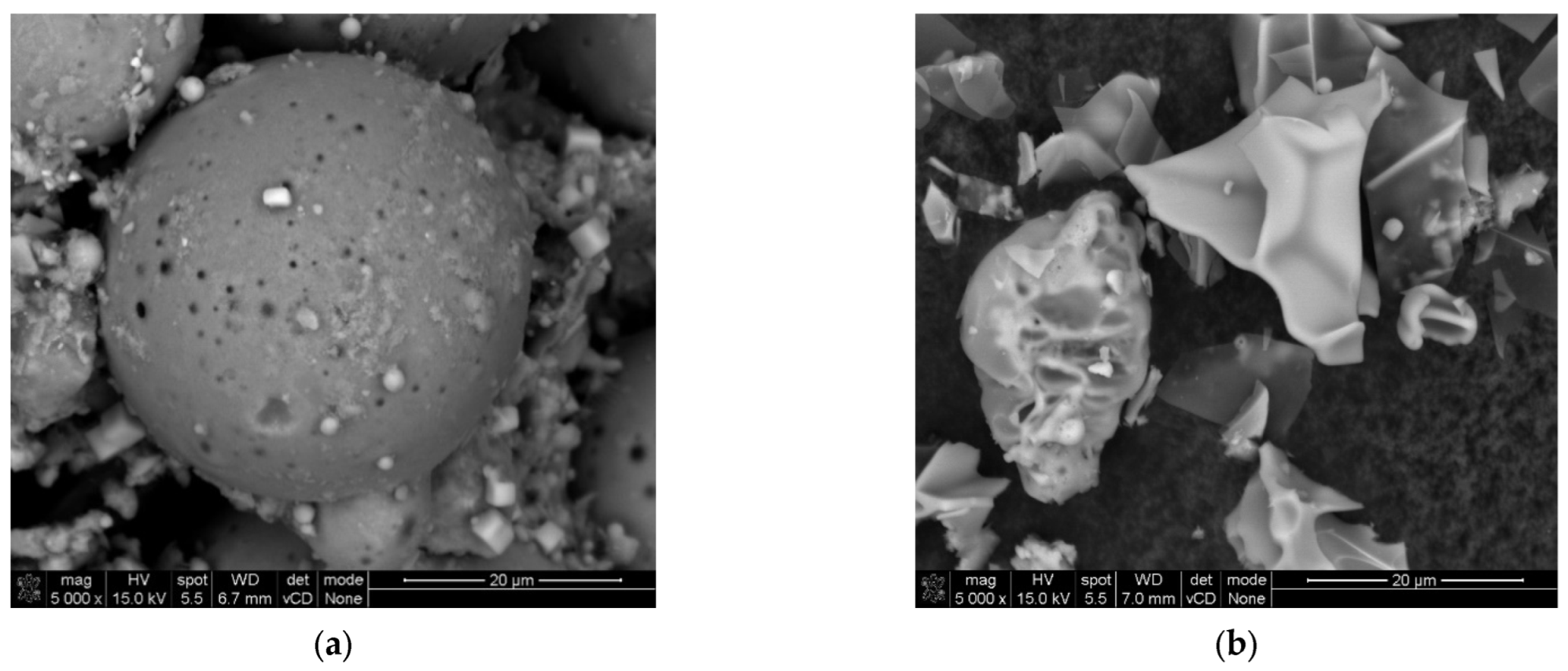

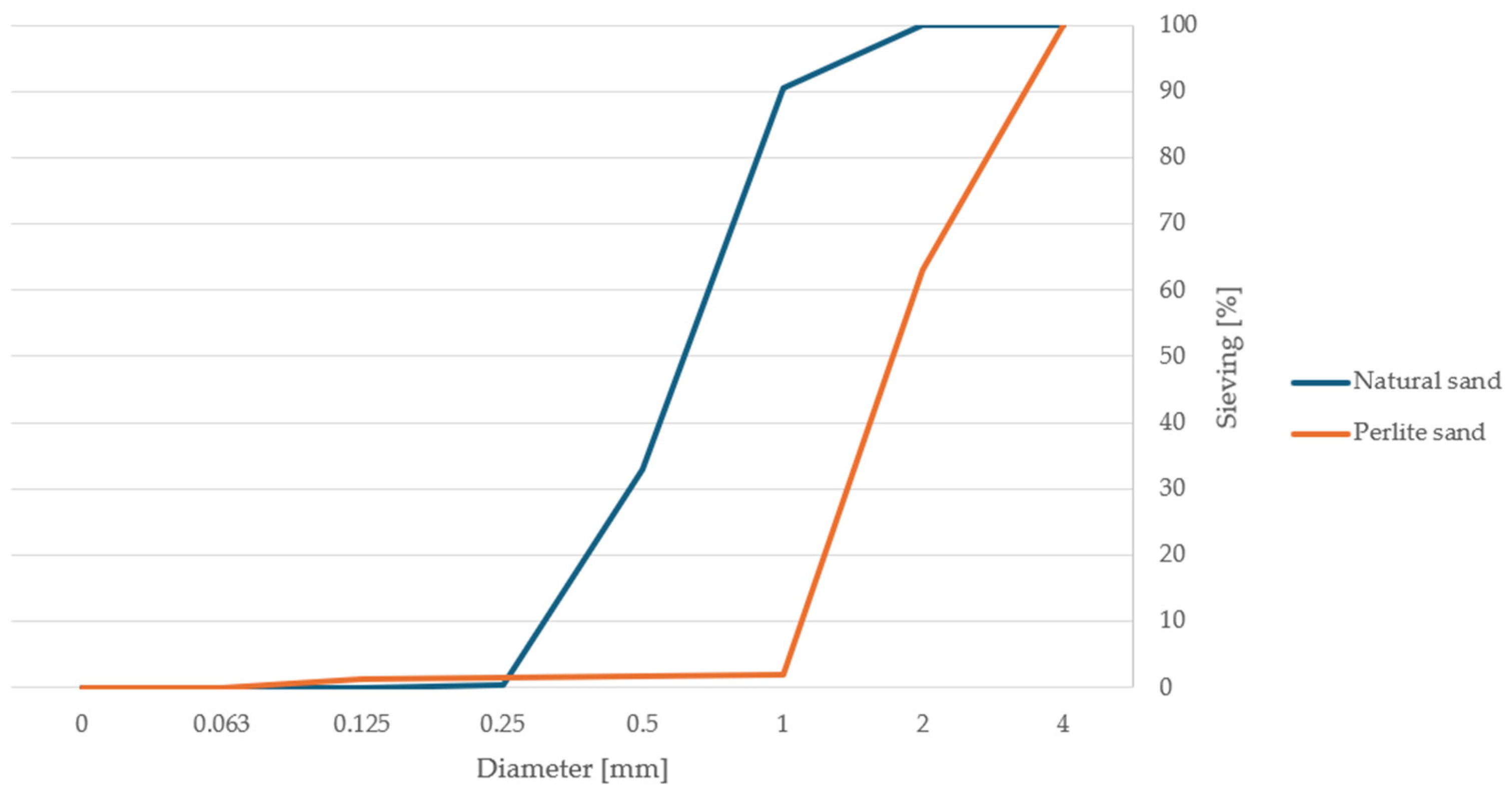
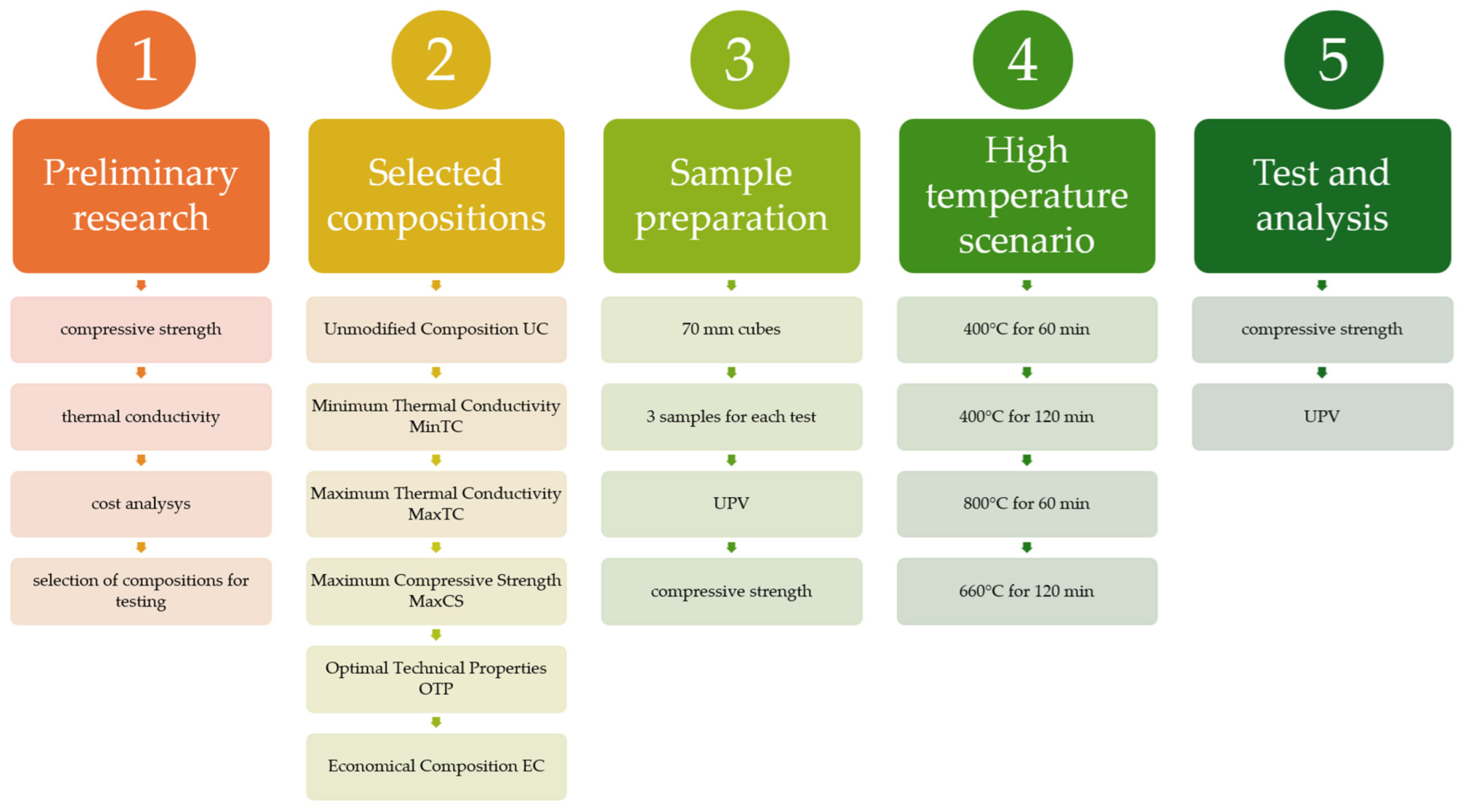
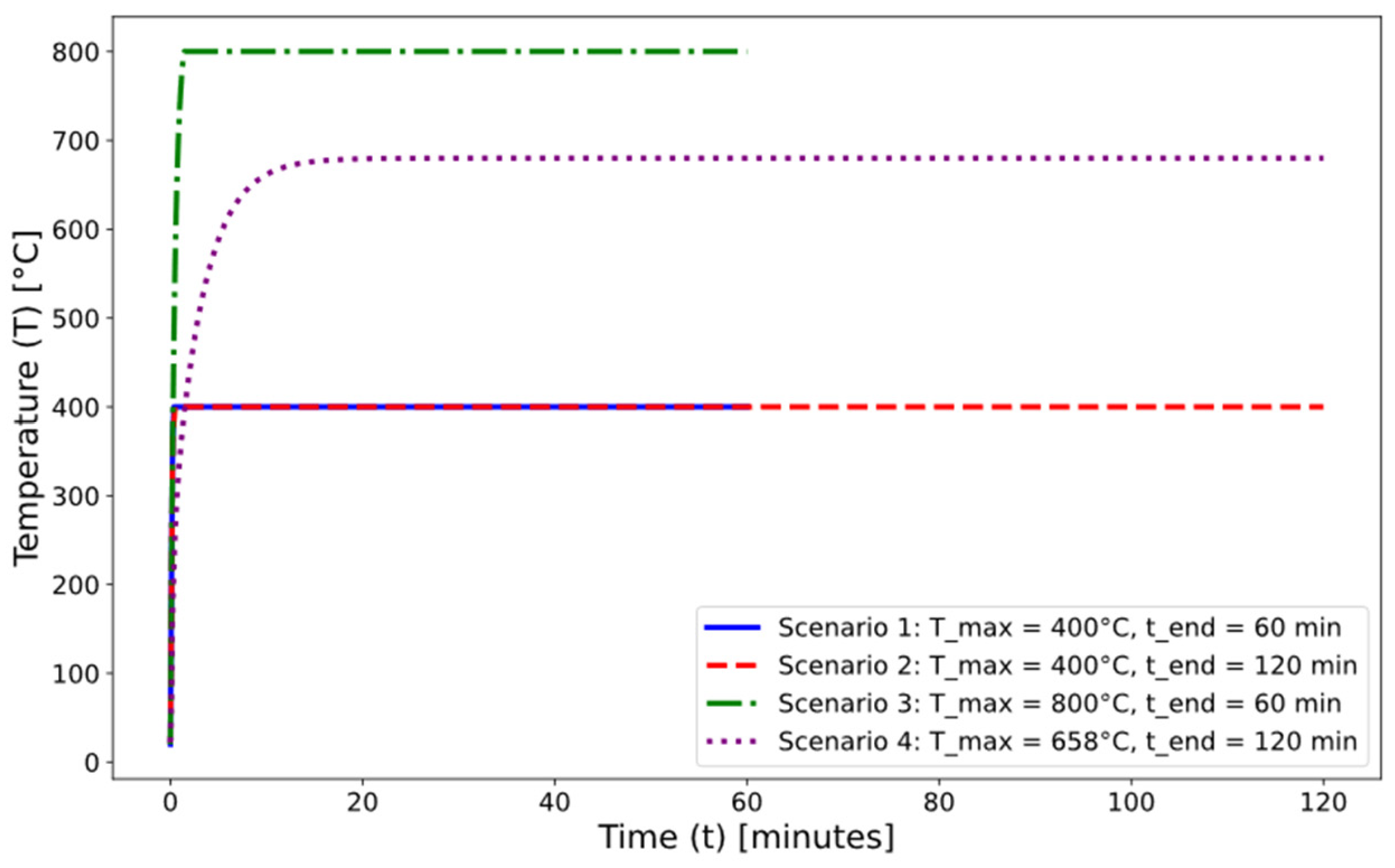

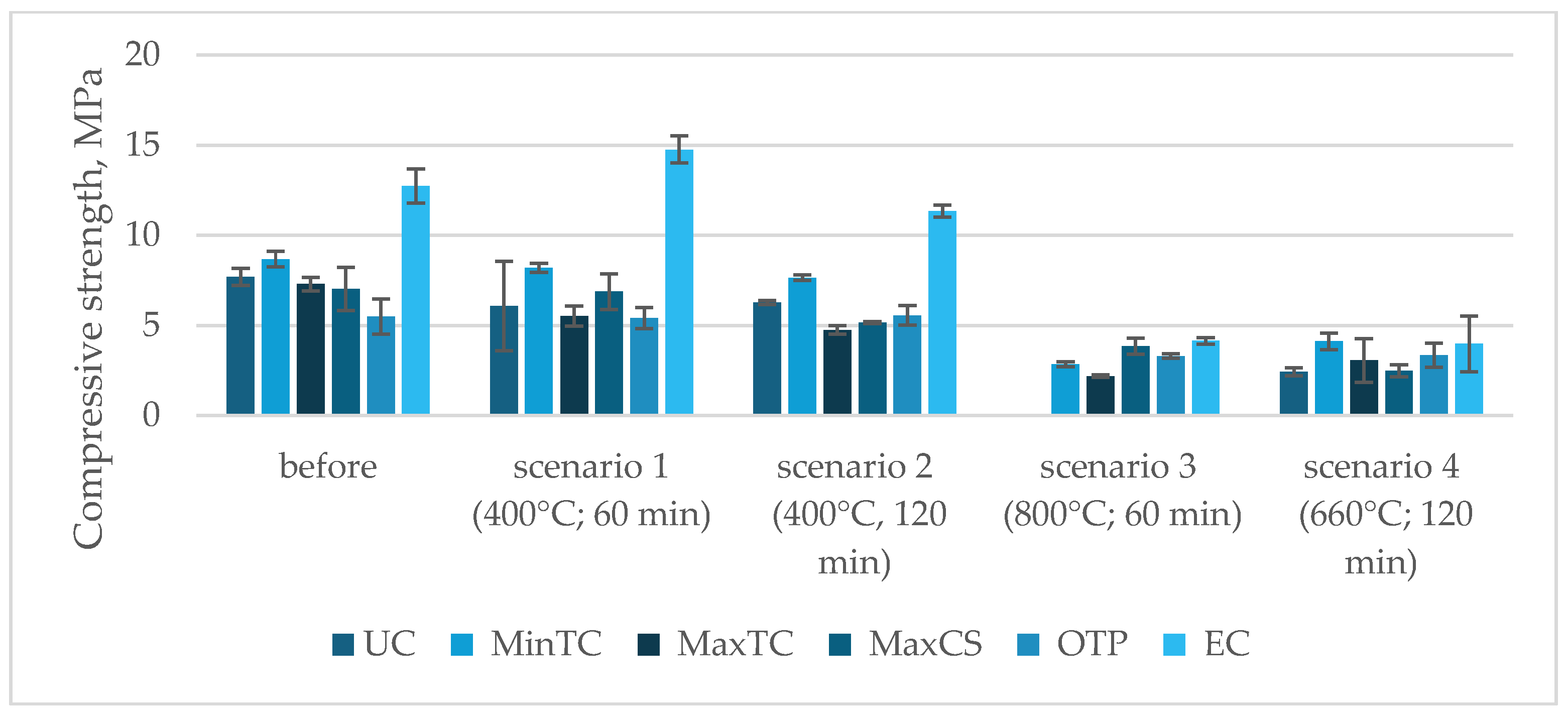
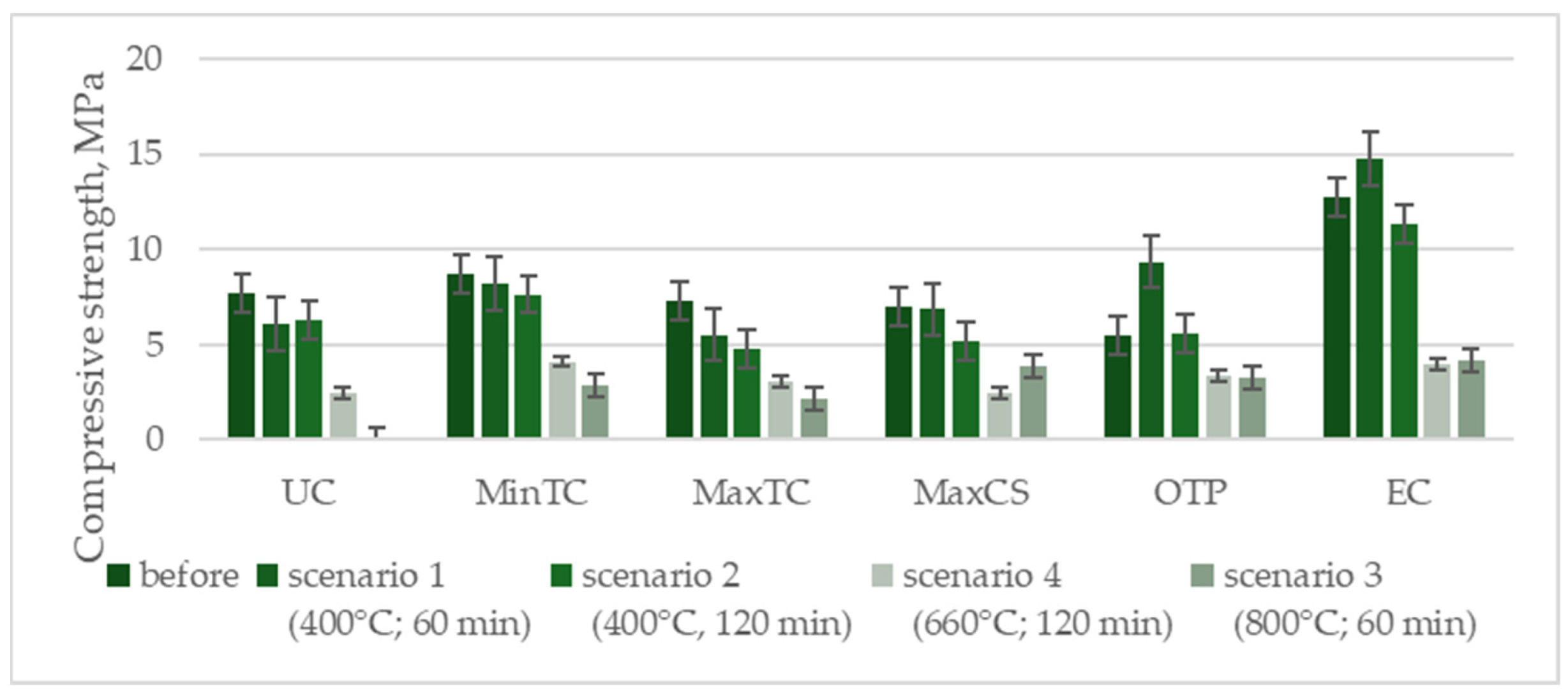

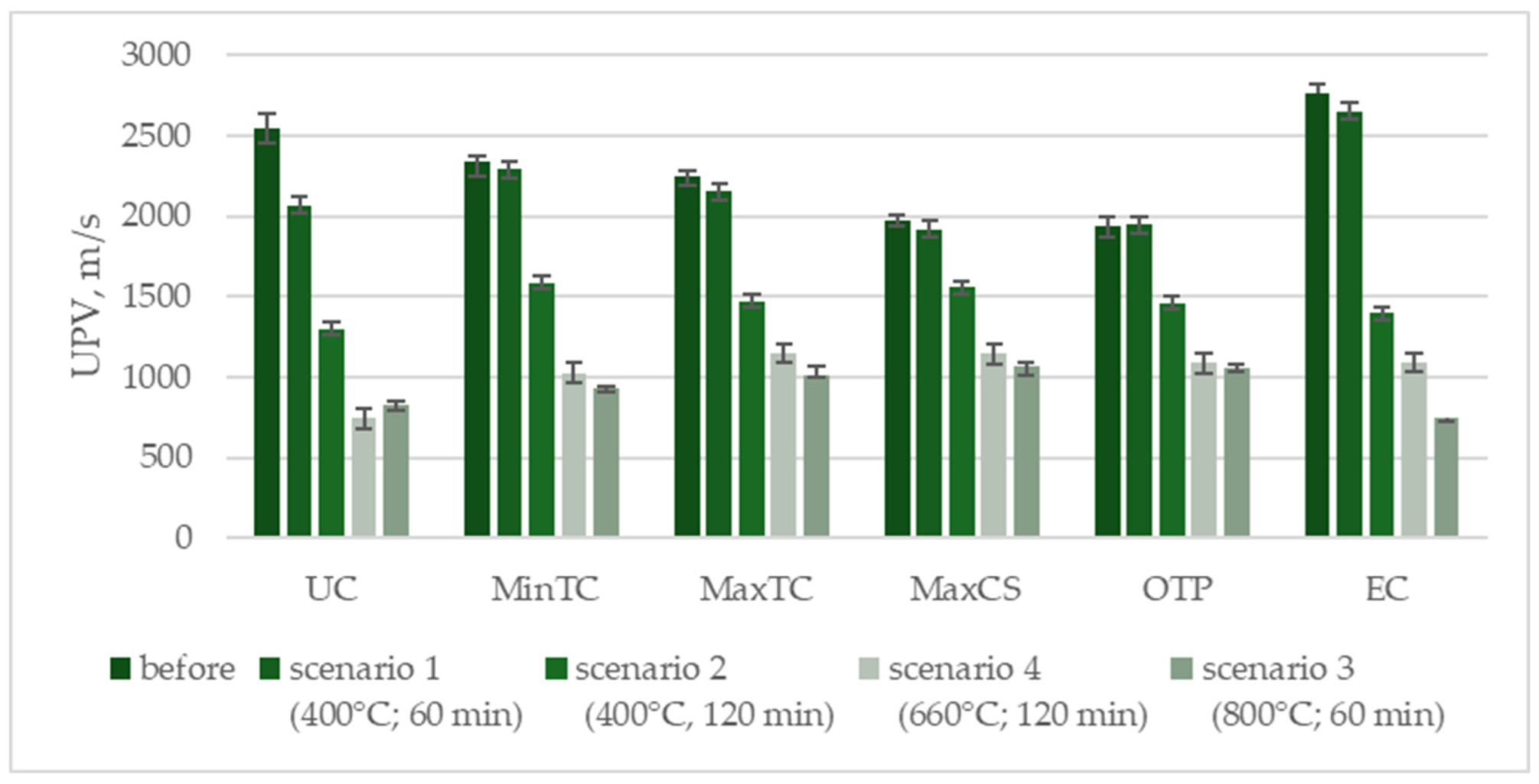
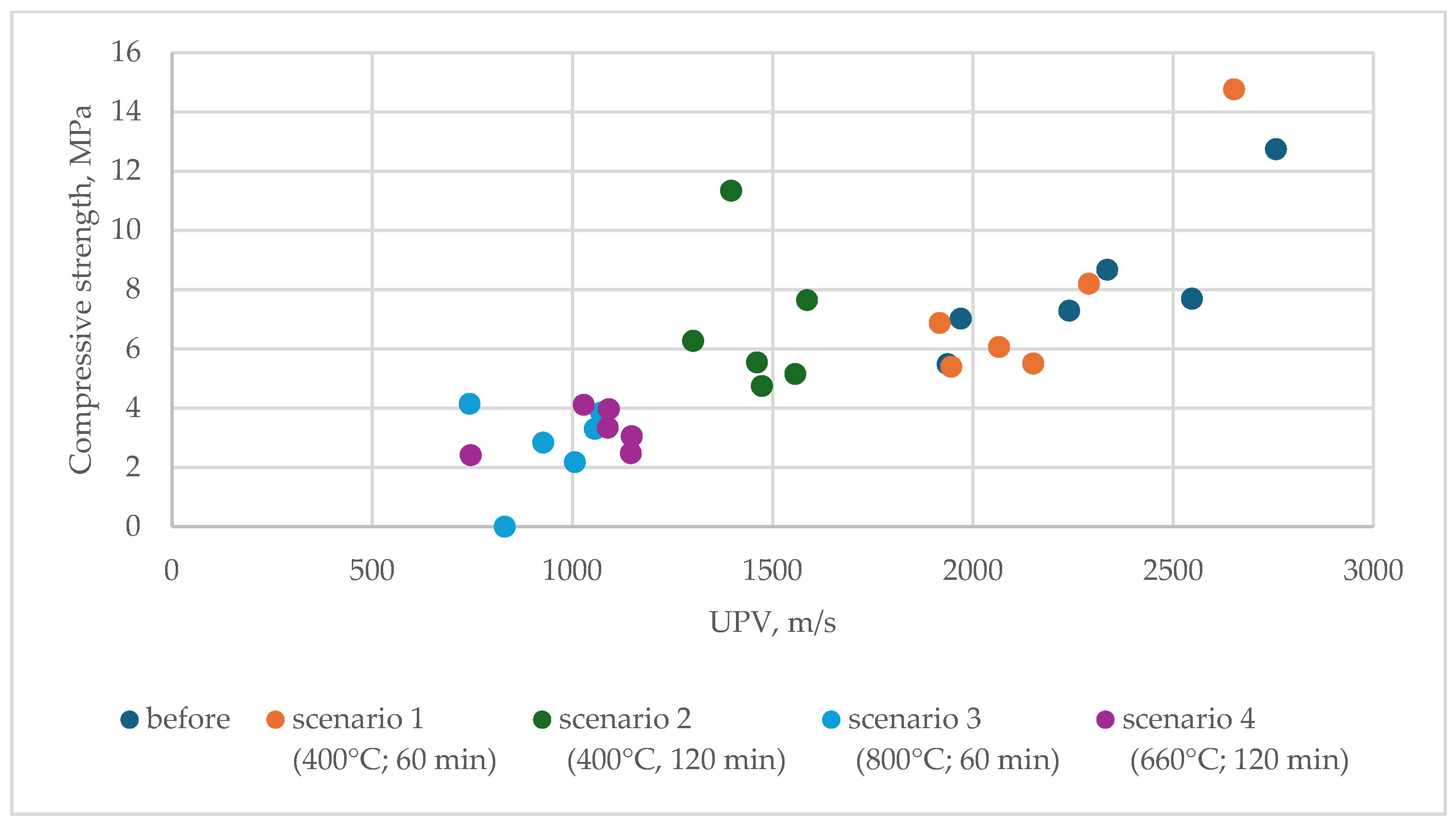
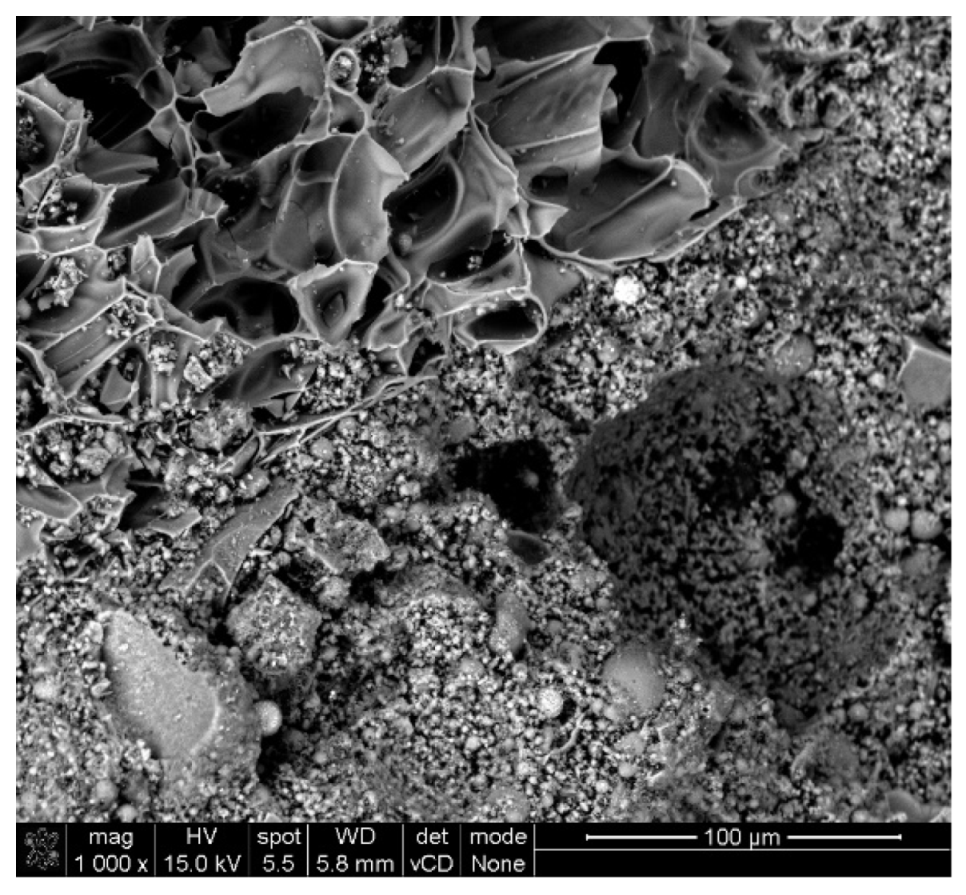
| Composition | Metakaolin | Zeolite | Fly Ash | Redispersible Powder | Methylcellulose | Calcium Formate | Natural Sand | Chalk | Hydrated Lime | Sodium Hydroxide (NaOH) | Water Glass (Sodium Silicate) | Water (H2O) | Perlite Sand | Perlite Powder | Cenospheres |
|---|---|---|---|---|---|---|---|---|---|---|---|---|---|---|---|
| UC * | 50 | 50 | 400 | 10 | 0 | 5 | 880 | 60 | 50 | 397 | 80 | 84 | 30 | 0 | 0 |
| MinTC * | 50 | 50 | 400 | 10 | 0 | 5 | 705 | 60 | 50 | 397 | 80 | 84 | 30 | 40 | 40 |
| MaxTC * | 50 | 50 | 400 | 10 | 0 | 5 | 636 | 60 | 50 | 397 | 80 | 84 | 30 | 5 | 75 |
| MaxCS * | 50 | 50 | 400 | 10 | 4 | 5 | 663 | 60 | 50 | 397 | 80 | 84 | 30 | 75 | 40 |
| OTPs * | 50 | 50 | 400 | 10 | 0 | 5 | 597 | 60 | 50 | 397 | 80 | 84 | 30 | 65 | 65 |
| EC * | 50 | 50 | 400 | 10 | 0 | 5 | 816 | 60 | 50 | 397 | 80 | 84 | 30 | 40 | 5 |
| Composition | Flexural Strength ft, MPa | Compressive Strength fc, MPa | Thermal Conductivity λ, W/(m·K) | Density kg/m3 |
|---|---|---|---|---|
| UC * | 1.8 | 4.6 | 0.2410 | 1540 |
| MinTC * | 1.6 | 3.5 | 0.1836 | 1510 |
| MaxTC * | 1.9 | 5.3 | 0.3127 | 1450 |
| MaxCS * | 1.9 | 6.7 | 0.2622 | 1540 |
| OTPs * | 1.6 | 5.6 | 0.2374 | 1480 |
| EC * | 1.6 | 5.0 | 0.2557 | 1580 |
| Composition | Before | After 1st Scenario | After 2nd Scenario | After 3th Scenario | After 4th Scenario |
|---|---|---|---|---|---|
| UC * | 7.7 ± 0.5 | 6.1 ± 2.5 | 6.3 ± 0.1 | 0.0 ± 0.0 | 2.4 ± 0.2 |
| MinTC * | 8.7 ± 0.4 | 8.2 ± 0.2 | 7.6 ± 0.1 | 2.8 ± 0.1 | 4.1 ± 0.5 |
| MaxTC * | 7.3 ± 0.4 | 5.5 ± 0.6 | 4.7 ± 0.2 | 2.2 ± 0.1 | 3.1 ± 1.2 |
| MaxCS * | 7.0 ± 1.2 | 6.9 ± 1.0 | 5.2 ± 0.1 | 3.9 ± 0.4 | 2.5 ± 0.3 |
| OTPs * | 5.5 ± 1.0 | 5.4 ± 0.6 | 5.5 ± 0.5 | 3.3 ± 0.1 | 3.3 ± 0.7 |
| EC * | 12.7 ± 0.9 | 14.8 ± 0.8 | 11.3 ± 0.3 | 4.1 ± 0.2 | 4.0 ± 1.5 |
| Composition | Before | After 1st Scenario | After 2nd Scenario | After 3th Scenario | After 4th Scenario |
|---|---|---|---|---|---|
| UC * | 2547 ± 91 | 2065 ± 93 | 1302 ± 52 | 831 ± 35 | 747 ± 67 |
| MinTC * | 2336 ± 36 | 2290 ± 10 | 1586 ± 24 | 927 ± 15 | 1028 ± 90 |
| MaxTC * | 2241 ± 35 | 2151 ± 11 | 1474 ± 27 | 1007 ± 10 | 1149 ± 30 |
| MaxCS * | 1970 ± 32 | 1917 ± 18 | 1557 ± 67 | 1072 ± 58 | 1146 ± 59 |
| OTPs * | 1937 ± 53 | 1946 ± 38 | 1461 ± 33 | 1056 ± 22 | 1088 ± 131 |
| EC * | 2727 ± 64 | 2652 ± 31 | 1397 ± 86 | 743 ± 23 | 1091 ± 139 |
Disclaimer/Publisher’s Note: The statements, opinions and data contained in all publications are solely those of the individual author(s) and contributor(s) and not of MDPI and/or the editor(s). MDPI and/or the editor(s) disclaim responsibility for any injury to people or property resulting from any ideas, methods, instructions or products referred to in the content. |
© 2024 by the authors. Licensee MDPI, Basel, Switzerland. This article is an open access article distributed under the terms and conditions of the Creative Commons Attribution (CC BY) license (https://creativecommons.org/licenses/by/4.0/).
Share and Cite
Kępniak, M.; Zabawski, J.; Prochoń, P. Enhancing Fire Resistance of Geopolymers Modified with Thermal Insulation Additives. Materials 2024, 17, 4854. https://doi.org/10.3390/ma17194854
Kępniak M, Zabawski J, Prochoń P. Enhancing Fire Resistance of Geopolymers Modified with Thermal Insulation Additives. Materials. 2024; 17(19):4854. https://doi.org/10.3390/ma17194854
Chicago/Turabian StyleKępniak, Maja, Jakub Zabawski, and Piotr Prochoń. 2024. "Enhancing Fire Resistance of Geopolymers Modified with Thermal Insulation Additives" Materials 17, no. 19: 4854. https://doi.org/10.3390/ma17194854






